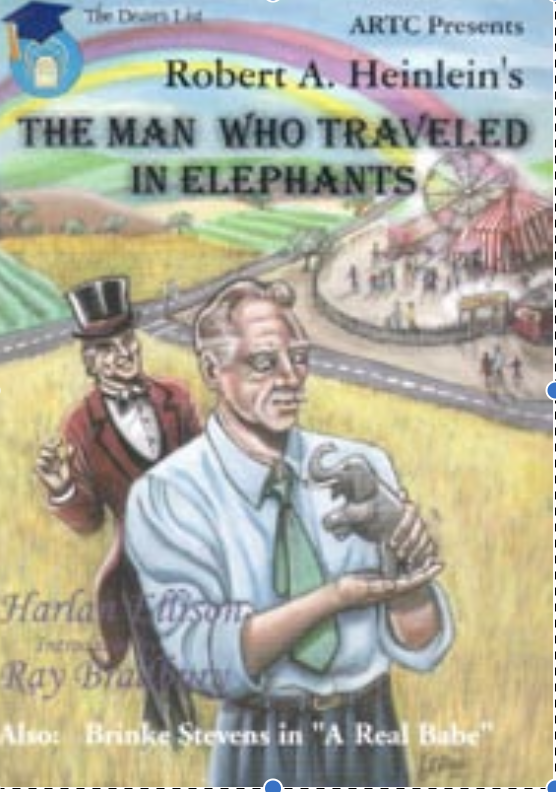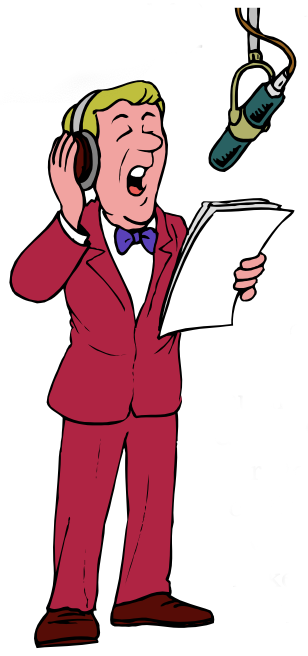
Prometheus
Newsletter of the LFS

Radio more than once sparked major changes in my life. As a high school kid in western Norway in the mid-1980s it opened up worlds for my music sensibilities as I listened to John Peel's BBC Radio 1 shows late at night on old portable. As a college student in the early 1990s in Austin, Texas, driving an old VW bug with only AM radio, it fired an interest and love for baseball listening to college and professional broadcasts. Where TV failed in igniting the imagination, as baseball on the small screen is far duller than in real life, radio listeners must pay greater attention, and the announcer's spare no effort in their descriptions.

In 1998 I conducted an interview with and that ran as a two-parter in the pages of Prometheus, called “Traveling in Elephants” (Volume 16, No. 3 & 4). and had just completed their first adaptation of a short story, “The Man Who Traveled in Elephants,” into a radio audioplay performed by the Atlanta Radio Theatre Company. This group, which might be called an amateur production company with professional abilities, put together performances at local sf shows and other venues, and recorded these as well for sales as CDs. In 1995 I witnessed one of their many live performances at DragonCon. Although many years passed and I never heard “The Man Who Traveled in Elephants,” I kept thinking about reviewing it for Prometheus. In 2005 I checked out the ARTC web site and saw that they had adapted two more stories, all available online to order as CDs under their Dean's List program. Call me a procrastinator, but I didn't order the three CDs until the summer of 2006.
The age of radio broadcasts for entertainment purposes dates back to the 1920s, whereas wireless transmission dates back even further. With all the different forms of entertainment available to radio, such as sports, religious sermons, political talk formats, and music, adapting the written word into a form of audio theatre is merely one other format. And yet, there's an inherent nostalgia around this format, for in our present age listening to a play seems quite old-fashioned compared to watching TV or renting DVDs. 1938 adaptation of story, “War of the Worlds,” on his show entitled The Mercury Theatre of the Air, stands out perhaps as the pinnacle of the power of entertainment on radio. In those days the lines between news and entertainment were still blurred. The imagination of the mind so suited for radio made it quite popular as a way to reach millions of eager young kids and adults, especially fans of the growing science fiction genre.
In the 1950s NBC carried two shows of adapted science fiction stories, Dimension X(1950-1951) with 50 stories by now well-known writers in the field, and X Minus One (1955-1958); the latter started as a revival of Dimension X, but offered over 100 new episodes. Some of the stories adapted into audio plays on Dimension X included classics by , , , and others (available as mp3 files at <http://www.archive.org/details/Dimension-X>). Four of the works were originally written by —“Requiem,” “The Green Hills of Earth,” “Universe,” and “The Roads Must Roll.” Radio and pulp sf seemed like perfect partners because they both embrace and extend our sense of imagination and wonder, but aside from a brief revival in the early 1970s, and the occasional aficionados keeping the format alive, other formats now rule the air waves.

Each of the three plays run around 30 minutes. The $12 (plus shipping) CDs are packaged in a DVD style box, and whereas the cover of “The Man Who Traveled in Elephants” bears a full-color painting, the two other packages are more subdued and consistently designed. other stories are mentioned as part of the Dean's List—“Our Fair City” and “All You Zombies…” but are not listed on the ARTC web site.) Rounding out each of the CDs are one or two smaller plays, including 's ghost story, “A Perfect Babe.”
Adapting the written word for audio goes far beyond merely reading the pages out load. Just as screenwriters do more than transcribe books into movies, anyone adapting a story must take into effect the order of events, characters and dialog, and even adding material. At the same time, care must be made to retain the original idea that formed the story. The final product is often quite different from the original source material in its presentation. When you add actors who emphasize certain elements of their voice and tone, the effect can either distract or enhance the listening experience. Special effects come to play as well, contributed by Foley artists adept at the way sound influences the story. This is perhaps seen with greater effect in movies, but strip out everything except the dialog, and while often you end up with something quite boring, too much sound acts also as overkill. The movie Cast Away notoriously left out a musical score for much of the movie, emphasizing the isolation of the main character, while horror movies like Saw and Psycho are inextricably linked to score and audio effects.

The oldest story of the trio, “Solution Unsatisfactory,” appeared in Astounding Science Fiction in 1940, under the byline . Written before the American entry into World War II, before Pearl Harbor and Hiroshima, this story details the escalating search for weapons of mass destruction amidst the very real events of that same war. A dramatic introduction prefaces the production, which was adapted by Daniel Taylor. John DeFries, the story's narrator, relates how he was shoved from an ordinary life into the council of rulers, and found that these rulers were ordinary men like himself, just as prone to error and confusion. As America remains outside the current war (fought primarily in the air between Great Britain and Nazi Germany), military leaders in the States are preparing for what they see as the inevitable entry into the war. To this end, Colonel Clyde Manning seeks out scientific solutions, and stumbles upon an awesome weapon with devastating consequences. DeFries works for Manning, and witnesses the discovery of radioactive dust, which in Heinlein's story replaces what our history went through with the atomic bomb. This dust, when spread by air can kill an entire city in slow agonizing death. As the president and his council debates whether or not to use this dust, they are keenly aware of their now absolute power, and the corrupting effects of such power. Will the republic stand, or wither away into tyranny by the one who controls the dust? In the end, after several warnings and demonstrations, the president decides to employ the dust against Germany, and wipes out every living being in Berlin. Just as the destruction of Hiroshima and Nagasaki were justified on the grounds that countless lives were spared from a costly ground invasion, the president and Manning see this as an opportunity to end the war now, and Germany quickly capitulates. Yet the war is not over, for now the race is on for other nations to secure their dust. Manning see this as a greater threat than individual liberty and a constitution, and goes to great lengths to secure a monopoly of dust, as a sort of benevolent dictator. The result is indeed a solution unsatisfactory.
The audio play, on the other hand, is superbly done. The dramatic tone is sustained and heightened by snippets of radio newscasts, and all the characters perform their lines with seriousness and gravity. Considered in the light that the ARTC recording session for the play took place on September 12, 2001, that tone is all the more understandable. I remained riveted to my headphones.
Although wrote “The Man Who Traveled in El- ephants” in 1948, the story did not appear in print until 1957. Generally seen as a fantasy, the story falls outside 's normally rigorously crafted science fiction mechanics. The adaptation of this story features the inimitable and often histrionic voice of , and an introduction by none other than . It contains a full range of audio effects, from trumpeting elephants, crowds, to the ever-annoying circus organ music in the background. Adapted by , whose own experience with carnies serves him well, centers around John Watts, who after retirement used to travel around the country with his wife, Martha. Under the guise of selling elephants, they visited fairs, expositions, and circuses, until Martha's death left him alone. Now, Watts rides on a final bus-ride to the greatest circus of them all.
, who appears as the ring master, at times channels Robin Williams, but also has the range of voice and talent to pitch a sale softly. As Watts and the listener slowly discovers the true destination, one can see why this story was one of 's favorites. The sense of humanity and enduring love in this story is such that it could bring a tear to the eye of even the most stoic listener.

Appearing firmly within 's Scribners juvenile period is the delightful tale of young Holly Jones, “The Menace from Earth.” Much like who adapted the tale, this has long been one of my favorite stories, all because of the protagonist. This 15 year old geeky girl resident of Luna City is forced to guide a gorgeous groundling from Earth, and learns about life and love in the process. Holly Jones is all business. She's an aspiring space ship designer (working on the star ship Prometheus) with her partner, a slightly older boy, Jeff Hardesty. Holly finds herself guiding around a gorgeous groundling visiting the Moon, the actress Ariel Brentwood. Well-aware of physical shortcomings when compared to Ariel, little Holly struggles with the prospect of losing Jeff, unaware of her love for him, and blind to how much he cares for her.
The story rotates around Holly, and the play uses both an inner voice or narration as well as the standard dialog of a play. The actress doing Holly's voice switches between the two formats with ease, and you can sense the teenage rush of thoughts from the tone and word use. Her spoken voice is far calmer, like someone trying to appear more grown up, especially when dealing with someone like the sophisticated Ariel. The play is rife with engineering metaphors. might have based the character on a fictionalized young Virginia Heinlein, his third wife, who was an engineer like himself. He certainly understood the language, and Holly's grasp of the terms and concept seems dizzying for someone her age, and makes her seem all the more vulnerable.
Aside from Holly and Ariel, there are only five or so additional voices: Jeff Hardesty himself, who comes across as a nerdy dork; Holly's high school friend Mary, who steps in now and then to push Holly into action; Holly's dad, a very typical father totally clueless about his teenage daughter's thoughts or feelings, but who grants her a great deal of leeway in her life. The pivotal scene in the Bats's Cave, where Lunarians fly through use of artificial wings, thick air, and low gravity, is handled quite nicely. The credits roll after the final chapter. 's adaptation is masterfully executed and compelling; I enjoyed this version so much that I immediately wanted to seek out the original story and read it again.
Four smaller stories that appear on the CDs: 's “The Assassins” and 's “Grandma's Diary” on ‘Solution Unsatisfactory’, 's “A Real Babe” on ‘The Man Who Traveled in Elephants’, and 's “Rory Rammer – Space Marshall” on ‘The Menace from Earth’. 's “A Real Babe,” which originally appeared in Peter Straub's anthology, Ghosts, is hands down the best of the non- tales. Featuring scream queen Brinke Stevens in a role almost written for her, as an intelligent actress who aspires beyond bimbo roles in low-budget movies (Stevens herself is a writer, producer, and director in addition to her countless movie roles), her sultry voice transcends the story and other characters.
Individually, these three audio plays represent new ways to understand 's stories. The writer who stares at the written word and must transform them into live, spoken voices probably must feel some trepidation at the task ahead. And yet, the transition in these plays seem seamless. No two stories are alike, from the serious ideas of “Solution Unsatisfactory,” to the awkward teenage angst of “The Menace from Earth,” and lastly the joyful tale of love and life amid the circus like atmosphere of “The Man Who Traveled in Elephants.”

The work done by ARTC each year to maintain and extend old time radio shows the power of their passion. Their labor of love continues to yield strange and wondrous fruit such as these adaptations, as well as other works. Their CDs are both great entertainment and an investment in our sf past. One can only hope that more of 's stories become available soon in the same format. No longer limited by tape or CD, digital players like the iPod allow people to listen to these plays while in the car, jogging, or relaxing at home. You no longer need to be huddled around cathedral radio sets to experience the sounds of sf.
|
All trademarks and copyrights property of their owners. |